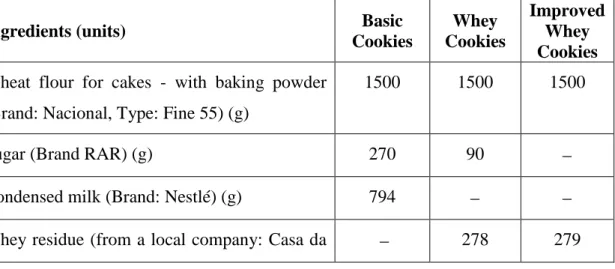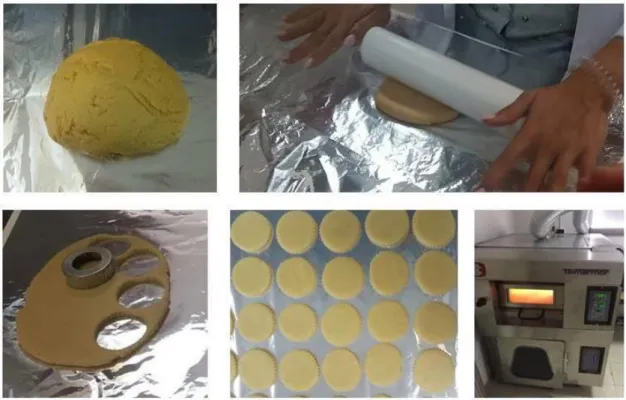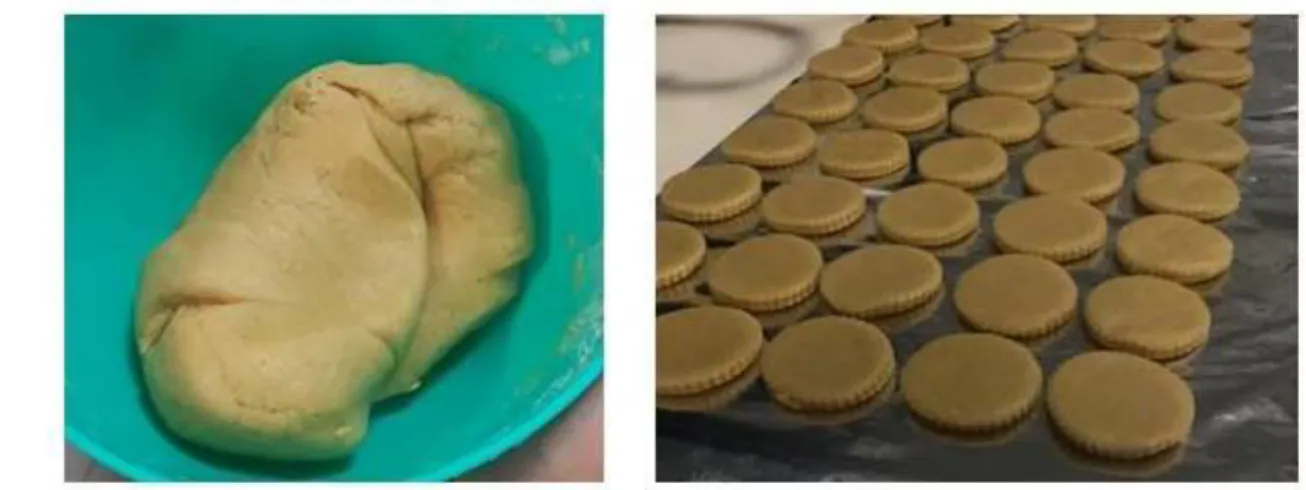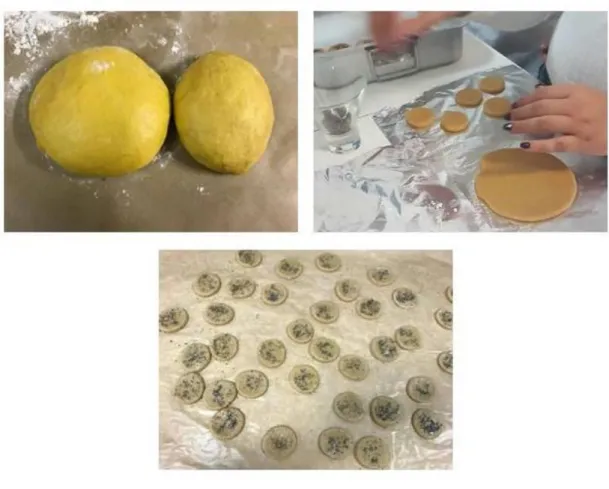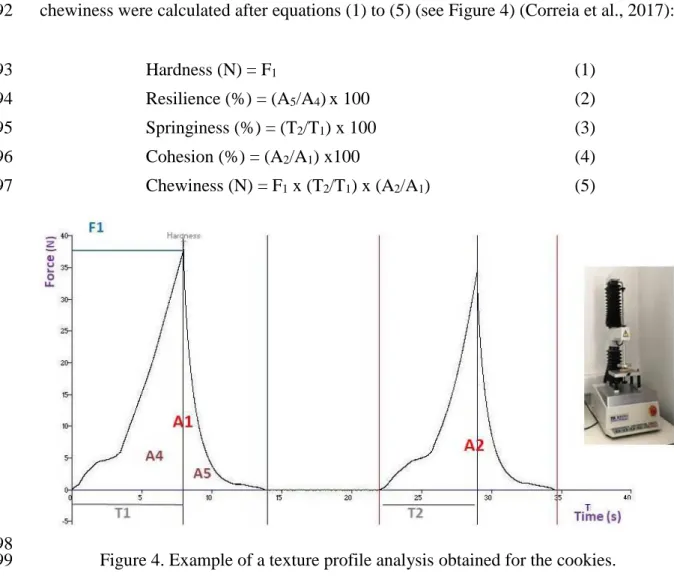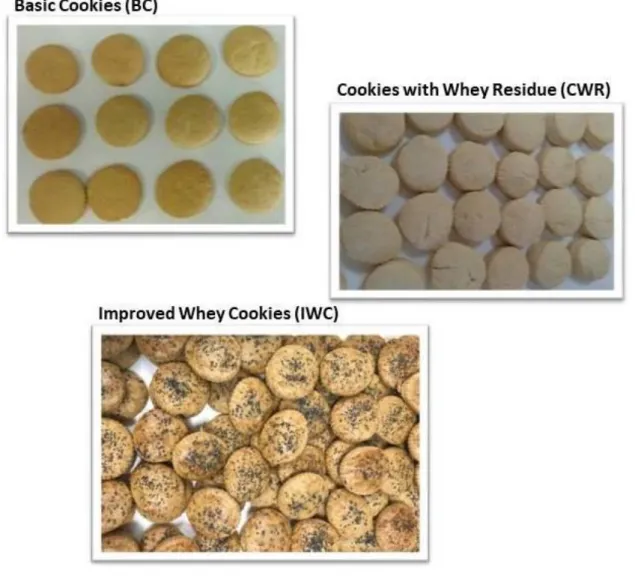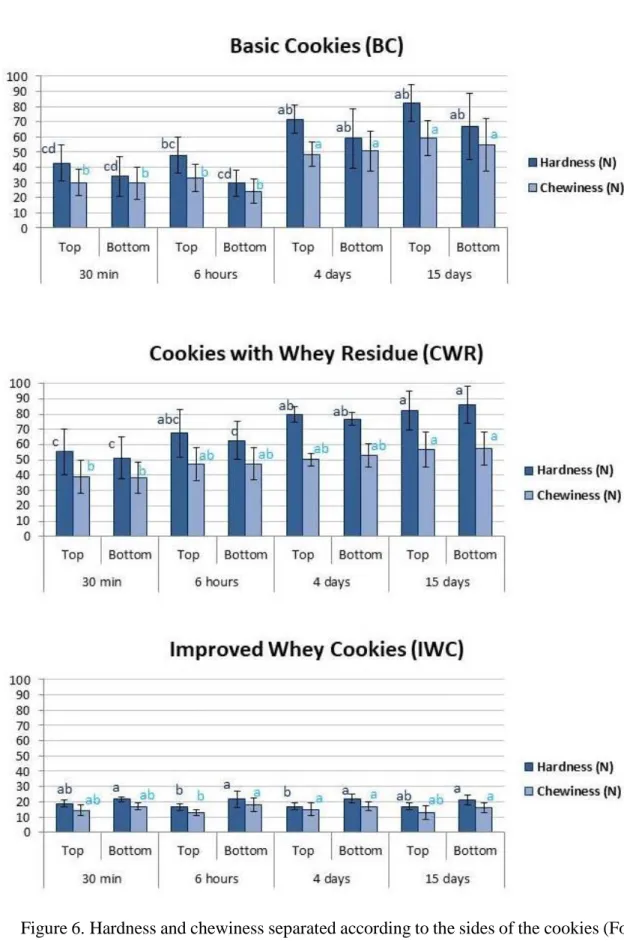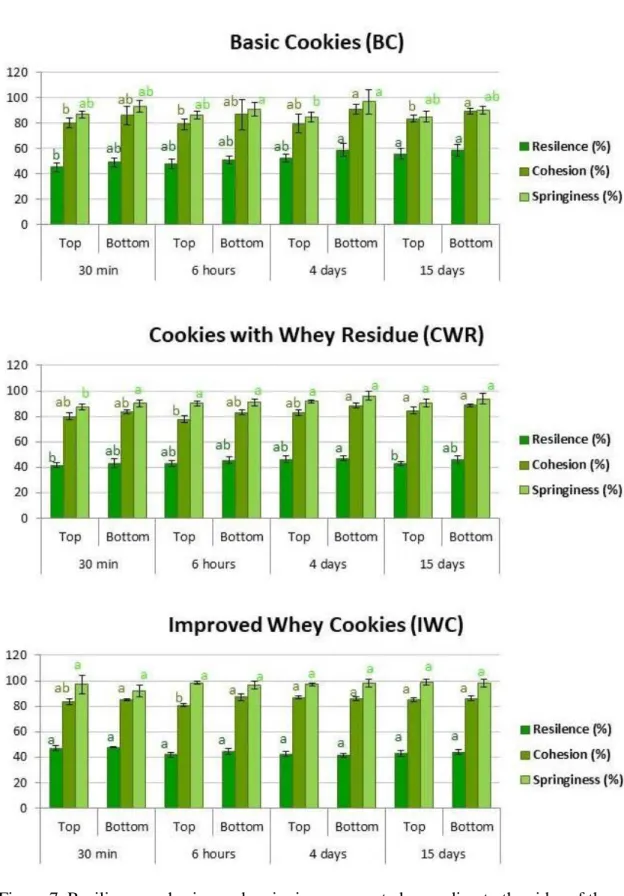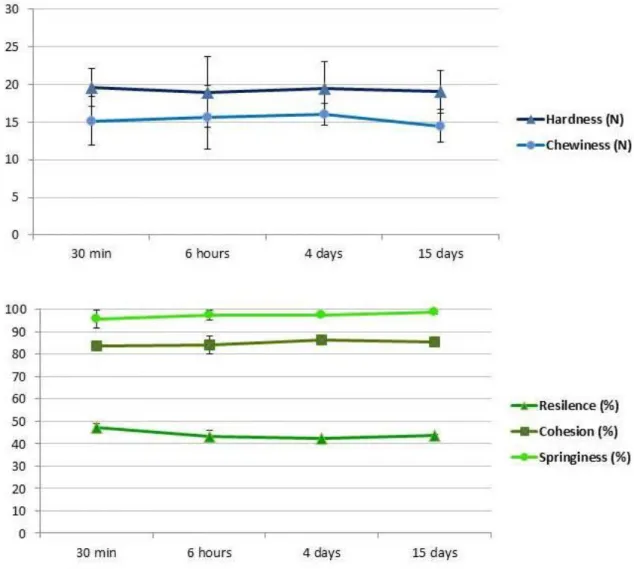1
1
Textural Properties of Newly Developed Cookies
2Incorporating Whey Residue
3Short Title: TEXTURE CHARACTERISTICS OF WHEY COOKIES 4
5
Raquel P. F. GUINÉ1*, Ana SOUTA2, Buse GÜRBÜZ2, Elisabete ALMEIDA2, 6
Joana LOURENÇO2, Liliana MARQUES2, Raquel PEREIRA2, Rubina GOMES2 7
8
1. CI&DETS/CERNAS Research Centre, Dep. Food Industry, Polytechnic Institute
9
of Viseu, Portugal
10
2. Dep. Food Industry, Agrarian School of Viseu, IPV, Viseu, Portugal,
11 12
*Address correspondence to:
13
Professor Raquel P. F. Guiné, Quinta da Alagoa. Estrada de Nelas. Ranhados. 3500-606 14
Viseu. Portugal. 15
Tel: +351 232 446641; E-mail: raquelguine@esav.ipv.pt 16
17
Acknowledgments
18This study was supported by Instituto Politécnico de Viseu/CI&DETS through 19
project PROJ/CI&DETS/CGD/0007 and FCT - Fundação para a Ciência e Tecnologia, 20
I.P., under the project UID/Multi/04016/2016. 21
The authors thank the company who provided the whey residue: Casa da Ínsua, 22
Viseu, Portugal. 23
Author version
Published article / Citation:
Guiné RPF, Souta A, Gürbüz B, Almeida E, Lourenço J, Marques L, Pereira R, Gomes R (2020) Textural Properties of Newly Developed Cookies Incorporating Whey Residue. Journal of Culinary Science & Technology, 18(4), 317-332.
2
24 25
Abstract
26Cookies vary considerably in composition, shapes, flavours or textures, being much 27
appreciated by consumers, and providing easy ways of supplying nutrients and energy, 28
besides bioactive components. The objective of this study was to develop new 29
added-value cookies incorporating whey residue, which is a by-product from the dairy 30
industry, thus finding alternative ways to avail this waste. The cookies were then 31
evaluated for their textural characteristics by means of texture profile analysis. The 32
results obtained revealed that the improved whey cookies were different that the other 33
cookies, better looking and with better global appearance, and also presenting good 34
textural properties, with low hardness and chewiness, allied to high springiness and 35
cohesion, being thus suitable for elderly and children with increased eating difficulties. 36
Furthermore, these properties were maintained along the storage period considered of 37
15 days, thus guarantying stability of the textural characteristics. 38
39
Keywords: compression test, puncture test, residue valorisation, textural properties.
40 41 42
3
Introduction
43
Recently, the search for foods and beverages that provide positive health impacts has 44
increased all over the world. Therefore, exhaustive production of functional foods 45
(containing bioactive compounds) has arisen (Góngora Salazar, Vázquez Encalada, 46
Corona Cruz, & Segura Campos, 2018). According to the World Health Organization 47
(WHO) the desirable intake of bread in a healthy and balanced diet should be around 48
250 g per day (Góngora Salazar et al., 2018). However, in many countries the ingestion 49
of bread is far below these recommendations, and that is why cookies can fill this void 50
(Calle, 2012). 51
Cookies represent the most important category of snacks in the bakery industry and 52
can serve as effective vehicle for supplying nutrients. The three major ingredients in 53
cookies are flour, fat and sugar, as well as other minor ingredients like leavening agents, 54
salt, emulsifiers and yeast. Also the moisture content should be low, between 1 and 5%, 55
to ensure long shelf life and good textural characteristics (Jan, Panesar, & Singh, 2018). 56
Margarine and sugar are core ingredients in the formulation of cookies. However, some 57
alternatives are possible, combining the added health effects with functionality 58
improvement. Regarding fat, olive oil is a healthier choice, being rich in bioactive 59
molecules, most especially the fatty acids. Also, the distribution of the fat phase and the 60
interactions between fat and the other ingredients affect the texture and stability of the 61
product (Di Mattia et al., 2015; Paolini, Bontempo, & Camin, 2017). As for the sugar, 62
sucrose is the most frequently used sweetener in cookies formulation. However, 63
negative health effects have been attributed to sucrose intake, like for example 64
contributing to excessive calories intake, excessive weight gain as well as increased risk 65
of developing dental caries, type 2 diabetes, and cardiovascular diseases. By replacing 66
4
sucrose with honey advantages arise from the pharmacological actions of this natural 67
product, which has proved beneficial against several injuries and illnesses. The 68
beneficial effects of honey have been demonstrated and include antioxidant, 69
anti-inflammatory, antibacterial, antimutagenic, wound healing, antidiabetic, antiviral, 70
antifungal and anti-tumour activities (Caballero, 2013; Eteraf-Oskouei & Najafi, 2013; 71
Ramsay, Shriver, & Taylor, 2017). 72
According the United Nations, in 2050 the world population is estimated to exceed 73
9.2 billion, bringing additional challenges regarding food production and management. 74
This is why an efficient utilization of the natural resources becomes more and more 75
important. The utilization of organic residues in particular is advantageous, because 76
many residues and by-products of the food industry can be utilized to produce new 77
foods and/or ingredients with additional nutritional value and improved bioactive 78
properties (de Oliveira, da Silva Lucas, Cadaval, & Mellado, 2017; Keegan, 79
Kretschmer, Elbersen, & Panoutsou, 2013; Kirchherr et al., 2018; Pleissner et al., 2016). 80
Because cookies are variable in composition, shapes, flavours or textures, they are 81
very appreciated by consumers, and can become a viable option in the field of 82
functional foods. Their energy input is easily adjustable, since the consumer can choose 83
the desirable dosage. In this way, cookies are a potentially important vehicle for the 84
delivery of bioactive compounds that improve their biological functionality (Calle, 85
2012; Góngora Salazar et al., 2018). 86
Hence, the main focus of this study was to develop new added-value bakery products 87
(cookies) incorporating whey residue, a by-product from the dairy industry, so as to 88
give new opportunities ta resource with some nutritional relevance and at the same time 89
minimizing environmental impacts. Besides the development of the product and 90
5
formulation, also the textural characteristics of the cookies were evaluated due to the 91
importance of these characteristics for the consumer acceptance of this type of food. 92
93
Material and methods
9495
Preparation of the cookies
96
Table 1 shows the formulations used in the preparation of the three types of cookies 97
developed: a basic recipe, a modification to incorporate the whey residue as a 98
replacement for the condensed milk and an improved recipe, with inclusion of several 99
ingredients with additional nutritional and bioactive effects. All the ingredients were 100
purchased on a local market and were proper to include in food preparations. These 101
ingredients were bought and then stored appropriately in the laboratory until usage. The 102
only exception was the whey residue, which was provided by a local company that 103
produces cheeses and that is looking for an alternative use to this residue that otherwise 104
would be discarded as effluent. In the case of the whey residue, it was received in the 105
day before it was used and stored for some hours in the refrigerator. 106
107
Table 1. Ingredients used in the formulation of the different types of cookies. 108
Ingredients (units) Basic
Cookies Whey Cookies Improved Whey Cookies
Wheat flour for cakes - with baking powder (Brand: Nacional, Type: Fine 55) (g)
1500 1500 1500
Sugar (Brand RAR) (g) 270 90
Condensed milk (Brand: Nestlé) (g) 794
6
Ínsua) (mL)
Margarine (Brand: Vaqueiro) (g) 149 234
Eggs – mixed (Brand: Zezerovo) (g) 258 257 399
Baking powder (Brand: Royal) (g) 9 15 9
Sodium bicarbonate (Brand: Farmax) (g) 9 9 9
Cinnamon (Brand: Margão) (g) 6
Olive oil (Brand: Oliveira da Serra) (mL) 135
Honey (Brand: Beerural) (g) 240
Chia seeds (Brand: Iswari) (g) 30
Poppy seeds (Brand: Iswari) (g) 30
Cardoon leaves (From local production: ESAV) (g)
0.4
109
Basic cookies (BC)
110
All ingredients listed in Table 1 were mixed by gradually adding the wheat flour, 111
and kneading until forming a homogeneous mass. The dough was stretched with a 112
kitchen roll and the cookies were shaped using appropriate molds. The cookies were 113
distributed into pre-greased and floured trays and then oven baked at a temperature of 114
about 180 °C (180±2 ºC) for 40 minutes, in an industrial electrical oven (Brand 115
Teimarmor). Figure 1 shows the procedure used for the preparation of the cookies with 116
the basic recipe. 117
7
118
Figure 1. Preparation of the basic cookies (BC). 119
120
Cookies with whey residue (CWR)
121
The procedure for the production of these cookies was similar to that described 122
earlier for the basic cookies (Figure 2), however some changes were made with respect 123
to the ingredients used, by replacing the condensed milk with whey residue and 124
increasing the amount of margarine as well as reducing the amount of sugar. The 125
replacement of milk by whey residue was the main goal of this work, which intended to 126
incorporate whey residue into bakery products so as to attribute an added value to this 127
otherwise discarded residue. As to the other changes, increasing the amount of 128
margarine was intended so as to compensate the replacement of the condensed milk by 129
an aqueous product (the whey residue) thus conferring structure to the mixture. The 130
tentative to reduce the amount of sugar was considered having in mind the negative 131
8
effects of sucrose for health. The oven temperature was also increased to 240 ºC and as 132
a consequence the cooking time decreased to 15 minutes. 133
134
135
Figure 2. Preparation of the whey cookies (CWR). 136
137
Improved whey cookies (IWC)
138
The procedure used was the same as in the previous formulation (recipe with whey 139
residue). The margarine was replaced with olive oil, and the sugar with honey, besides 140
addition of some other ingredients aimed at improving the nutritional and healthy 141
properties of the final product. The biscuits were brushed with egg white and covered 142
on the surface with chia and poppy seeds, adding some decorative effect besides 143
providing nutritional effects (Figure 3). The oven temperature was also 240 ºC, however 144
the baking time was decreased to 10 minutes. 145
9
147
Figure 3. Preparation of the improved whey cookies (IWC). 148
149
For the tests, all cookie samples were left at room temperature for about 30 minutes 150
after oven baking for cooling, and then were placed inside common plastic bags which 151
were closed and left at room temperature for posterior analyses. The textural 152
determinations were made to the cookies 30 minutes after baking and again after 6 153
hours, 4 days and 15 days. 154
155
Consumption considerations
156
The developed cookies with the improved recipe are soft elastic biscuits that are 157
particularly suitable for elderly and children, who tend to have more difficulty in 158
chewing, although also very suitable for all groups of the population in general. Because 159
10
their formulation was designed to include some ingredients with possible bioactive 160
principles, they are also beneficial for people who what to improve their general health 161
status. For example, cinnamon has demonstrated thermogenic, anticarcinogenic and 162
antibacterial effects, allied to prevention and treatment of some chronic diseases such as 163
diabetes, Alzheimer and Parkinson's disease (Meghani et al., 2018; Ribeiro-Santos et 164
al., 2017; Vasconcelos, Croda, & Simionatto, 2018). 165
Olive oil is one of the basilar ingredients of the so called Mediterranean Diet, which 166
was recognized as UNESCO heritage, and has proved to have many benefits for the 167
human health due to the presence of fatty acids and phenolic compounds. Some of the 168
highlighted effects include: cardioprotection, chemoprevention, decreased risk for 169
neurodegenerative disorders, improve cardiometabolic factors and reduce type 2 170
diabetes risk, among others (Ntanasi et al., 2018; Visioli et al., 2018; Wani et al., 2018). 171
Honey is a natural sweetener particularly rich in dietary minerals and phenolic 172
compounds with antioxidant, antibacterial and anti-inflammatory activities and 173
demonstrated to be an ally in cancer treatment acting as as immune booster for patients 174
under chemotherapy (Badolato, Carullo, Cione, Aiello, & Caroleo, 2017; Deng et al., 175
2018; Yusof, Ahmad, Hamid M.S., & Khong, 2018). 176
Chia seeds are presently very popular due to their nutritious properties, namely high 177
fibre, protein, polyphenols and lipids, particularly fatty acids like omega-3, contents. 178
Some biological effects attributed to the seeds are, for example, help to maintain energy 179
levels but with a low-glycemic index, help achieve daily iron intake and fuction as ally 180
in primary cardiovascular disease prevention (Laczkowski et al., 2018; 181
Rendón-Villalobos, Ortíz-Sánchez, & Flores-Huicochea, 2018; Tenore et al., 2018; 182
Zettel & Hitzmann, 2018). 183
11 Evaluation of texture
185
For the assessment of the textural characteristics the texture profile analysis was 186
performed using a texturometer TA-XT2 Plus from Stable Microsystems. The test 187
involved two compression cycles using a flat probe with 75 mm diameter (P/75), 188
separated by 5 seconds. The parameters used for the test were: 30 kg force load cell, 189
pre-test, test and post-test speeds equal to 1.0 mm/s, distance 4 mm and trigger force 0.1 190
N. The textural properties: hardness, resilience, springiness, cohesiveness and 191
chewiness were calculated after equations (1) to (5) (see Figure 4) (Correia et al., 2017): 192 Hardness (N) = F1 (1) 193 Resilience (%) = (A5/A4)x 100 (2) 194 Springiness (%) = (T2/T1) x 100 (3) 195 Cohesion (%) = (A2/A1) x100 (4) 196 Chewiness (N) = F1 x (T2/T1) x (A2/A1) (5) 197 198
Figure 4. Example of a texture profile analysis obtained for the cookies. 199
200
For the textural evaluations 15 cookies of each type were used, and for each sample 201
one measurement was made on the top and another on the underside of the cookie. As 202
12
previously stated, the samples were evaluated 30 minutes after baking, and again 6 203
hours, 4 days and 15 days later, in order to determine the stability of the textural 204
characteristics along time. The results were processed using Exponent software TEE 205
from Stable Micro Systems. 206
The textural properties determined by the compression test were hardness, resilience, 207
springiness, cohesiveness and chewiness. Hardness represents the force necessary to 208
compress a food between the teeth or between the palate and the tongue. Chewiness 209
measures the energy required to disintegrate a food to a state suitable to swallow. 210
Springiness is associated with the ability to recover shape after compression, being 211
equal to the rate at which the product returns to the initial point after removal of the 212
deforming force. Resilience is the energy used when applying a force to a material 213
without occurring rupture, with or without any residual strain, and corresponds to an 214
instant springiness. Cohesiveness represents the internal forces inside the food that stop 215
the sample from disintegrating (Cruz, Guiné, & Gonçalves, 2015; R. P. F. Guiné, 216
Henriques, & Barroca, 2014; Raquel P. F. Guiné, Almeida, Correia, & Gonçalves, 217 2015). 218 219 Statistical analysis 220
To validate the results obtained for the mean values calculated, a comparison of 221
means was performed by an analysis of variance (ANOVA), with the Post-Hoc Tukey 222
HSD (Honestly Significant Difference) test for identification of differences between 223
samples. For all statistical analyses was used the software SPSS version 25 (IBM, Inc.) 224
and the level of significance considered was 5% (p < 0.05). 225
226
Results and discussion
22713 Comparison of the baked cookies
228
Figure 5 shows the three types of cookies produced. An organoleptic evaluation was 229
performed, using an untrained set of 16 tasters, whose principal conclusions are 230
presented as follows. Although not complying with all requisites of sensory analysis, 231
the highlighted aspects contribute for a better understanding of the sensory 232
characteristics of the different cookies. Regarding the basic cookies, it was observed 233
that this formulation resulted in unglazed biscuits due to the high cooking time, which 234
also led to the dehydration of the biscuits, turning them very dry. In the case of the 235
cookies with whey residue, after molding many cracks and deformations were observed, 236
weakening the appearance of the product, therefore alerting for a need to improve the 237
recipe, particularly producing cookies with better texture. In the case of the improved 238
whey cookies the dough presented a greater homogeneity, allowing an easy molding. 239
The cooking time was shortened to only 10 minutes so that the aromatic compounds 240
would not volatilize and therefore would provide a better flavour. The replacement of 241
margarine with olive oil turned the cookies less crunchy, thus giving them a soft texture, 242
perhaps more similar to biscuits. In this way, the new formulation with the introduction 243
of new ingredients was positive in terms of colour, texture and flavour. 244
14
245
Figure 5. The three varieties of cookies produced for the study. 246
247
Textural properties
248
Figure 6 presents the mean values of the textural properties hardness and chewiness 249
evaluated on the top and bottom faces of the three types of cookies and on different time 250
moments: shortly after baking, after 6 hours, 4 days and 2 weeks. The results were 251
subject to a statistical analysis to verify if significant differences were found in the mean 252
values for each property. 253
The results in Figure 6 show that the CWR presented in general highest hardness and 254
chewiness as compared with the other two types, BC and IWC. For the BC it was 255
15
observed that the hardness was maintained in the day of confection, at least until 6 256
hours, but the cookies became much harder after 4 days and remained then unchanged 257
until the end of the evaluation period of 15 days. Also the CWR showed an increase in 258
hardness right after 6 hours, although the greatest increase was also after 4 days. This 259
means that the textural characteristics of the BC and CWR were more difficult to 260
maintain during the storage. The IWC, which are the targeted cookies for marketing, 261
presented very uniform hardness and chewiness considering both sides of the cookie 262
(top and bottom), with quite low values, making these products more similar to soft 263
biscuits. Also, it was verified that time did not have any effect on texture, at least for the 264
period analysed of 2 weeks. This is a good indicator, because the product does not lose 265
its firmness on one hand and also does not become harder on the other hand. Regarding 266
the uniformity between both faces of the cookie, in all cases there was a trend to have 267
similar hardness and chewiness regardless on the side of the cookies. 268
16
270
Figure 6. Hardness and chewiness separated according to the sides of the cookies (For 271
the same property, bars with the same letter are not significantly different: ANOVA with 272
Tukey post-hoc test, p > 0.005). 273
17
In Figure 7 are shown the mean values of the textural properties resilience, cohesion 275
and springiness, on both sides of the cookies along the evaluation period considered, 276
from 30 minutes up to 15 days. The results show that the resilience is very uniform 277
between the sides and similar for all cookies, around 40%, being constant along time, 278
with just a slight reduction for the IWC cookies between the 30 min and 6 hours 279
observations, being constant thereafter. Regarding cohesion, the values were also 280
relatively similar for all the samples, varying between 77.82 and 91.04%, and with no 281
visible variations along time. Finally, springiness was similar for samples BC and CWR 282
and a little higher for the IWC, meaning that these were more elastic, which together 283
with the lower hardness made these cookies more tender. Again, in most cases no 284
significant differences were found for these three textural properties between the two 285
sides of the cookies, leading to uniform products. 286
287
18
288
Figure 7. Resilience, cohesion and springiness separated according to the sides of the 289
cookies (For the same property, bars with the same letter are not significantly different: 290
ANOVA with Tukey post-hoc test, p > 0.005). 291
19
Figure 8 shows the results considering the whole samples, i.e., as mean values of the 293
determinations made on the top and bottom faces of the cookies. As previously seen, the 294
properties hardness and chewiness showed some significant differences between both 295
sides, and that results in higher dispersion of the data for each sample, as the higher 296
values of the standard deviation for some of the samples indicate. The chart in Figure 8 297
(top) confirms that in all moments of evaluation the IWC presented lowest hardness and 298
chewiness, while the CWR presented the highest values for those textural attributes. 299
Again, the trends observed for both variables were parallel, due to the connection that 300
exists between them, as expressed by Equation (5). The bottom graph in Figure 8 shows 301
that while springiness is a little higher for the IWC as compared to the other two in all 302
moments of evaluation, cohesion tends to be similar and also approximately constant 303
along time. Regarding resilience, more variability was observed, with the values for the 304
BC after 4 and 15 days being the highest, as opposed to the IWC whose values were the 305
lowest in all determinations except for the 30 min. 306
307 308
20
309
Figure 8. Textural properties, considering each sample as a whole. Legend: BC = 310
basic cookies, CWR = cookies with whey residue, IWC = improved whey cookies. 311
312
Figure 9 represents the evolution along time of the textural properties for the IWC, 313
which are the target cookies intended for commercialization. The results indicate good 314
stability of all textural properties along time, for the 2 weeks period considered. 315
Naturally that further studies should include longer storage periods and conservation 316
under packaging, which was not considered in the present case, in which the cookies 317
were left in conventional plastic bags without proper sealing and appropriate packaging 318
materials, if industrial production is targeted. Nevertheless, for home prepared cookies 319
the expected shelf-life is shorter and the storage conditions include cookie cans or 320
21
plastic box containers, which much resemble those simulated in the present work. 321
322
323
Figure 9. Variation along time of the textural properties of the improved whey 324 cookies. 325 326 Culinary recommendations 327
The IWC are mild sweet snacks that can be eaten in between meals. Besides, they 328
can be consumed at breakfast together with milk, yogurt or natural fruit juices. In the 329
afternoon or just before bedtime they can be combined with a cup of hot tea and provide 330
comfort (Figure 10). 331
22
Apart from eating the IWC in the form of cookies, they can also be incorporated into 332
some deserts, providing alternative flavours to fruit creams, pies or dairy based deserts. 333
334
335
Figure 10. Serving suggestions of the improved whey cookies. 336
337
Conclusions
338The results obtained in this work showed that the developed cookies with an 339
improved recipe containing whey residue and ingredients with potential health benefits 340
had a satisfactory appearance and desirable global properties, as indicated by the results 341
of the organoleptic evaluation conducted by the set of tasters. Regarding texture and its 342
variation along an observation period of 15 days, it was verified that the IWC showed 343
good textural properties, with low hardness and chewiness, allied to high springiness 344
and cohesion, and that these properties were maintained along the storage period 345 considered. 346 347
Acknowledgments
348Removed for blindness purposes
349 350
23
References
351Badolato, M., Carullo, G., Cione, E., Aiello, F., & Caroleo, M. C. (2017). From the hive: Honey, a novel
352
weapon against cancer. European Journal of Medicinal Chemistry, 142, 290–299.
353
https://doi.org/10.1016/j.ejmech.2017.07.064
354
Caballero, B. (2013). Sucrose: Dietary Sucrose and Disease. In Benjamin Caballero (Ed.), Encyclopedia
355
of Human Nutrition (Third Edition) (pp. 231–233).
356
https://doi.org/10.1016/B978-0-12-375083-9.00257-9
357
Calle, J. (2012). Tendencias actuales en galletas funcionales: Reducción de calorías. Reciteia, 12, 26.
358
Correia, P., Guiné, R., Correia, A. C., Gonçalves, F., Brito, M., & Ribeiro, J. (2017). Physical, chemical
359
and sensory properties of kiwi as influenced by drying conditions. Agricultural Engineering
360
International, 19(3), 203–212.
361
Cruz, A. C., Guiné, R. P. F., & Gonçalves, J. C. (2015). Drying Kinetics and Product Quality for
362
Convective Drying of Apples (cvs. Golden Delicious and Granny Smith). International Journal
363
of Fruit Science, 15(1), 54–78. https://doi.org/10.1080/15538362.2014.931166
364
de Oliveira, L. M., da Silva Lucas, A. J., Cadaval, C. L., & Mellado, M. S. (2017). Bread enriched with
365
flour from cinereous cockroach (Nauphoeta cinerea). Innovative Food Science & Emerging
366
Technologies, 44, 30–35. https://doi.org/10.1016/j.ifset.2017.08.015
367
Deng, J., Liu, R., Lu, Q., Hao, P., Xu, A., Zhang, J., & Tan, J. (2018). Biochemical properties,
368
antibacterial and cellular antioxidant activities of buckwheat honey in comparison to manuka
369
honey. Food Chemistry, 252, 243–249. https://doi.org/10.1016/j.foodchem.2018.01.115
370
Di Mattia, C., Balestra, F., Sacchetti, G., Neri, L., Mastrocola, D., & Pittia, P. (2015). Physical and
371
structural properties of extra-virgin olive oil based mayonnaise. LWT - Food Science and
372
Technology, 62(1, Part 2), 764–770. https://doi.org/10.1016/j.lwt.2014.09.065
373
Eteraf-Oskouei, T., & Najafi, M. (2013). Traditional and Modern Uses of Natural Honey in Human
374
Diseases: A Review. Iranian Journal of Basic Medical Sciences, 16(6), 731–742.
375
Góngora Salazar, V. A., Vázquez Encalada, S., Corona Cruz, A., & Segura Campos, M. R. (2018). Stevia
376
rebaudiana: A sweetener and potential bioactive ingredient in the development of functional
377
cookies. Journal of Functional Foods, 44, 183–190. https://doi.org/10.1016/j.jff.2018.03.007
24
Guiné, R. P. F., Henriques, F., & Barroca, M. J. (2014). Influence of drying treatments on the physical
379
and chemical properties of cucumber. Journal of Food Measurement and Characterization, 8(3),
380
195–206. https://doi.org/10.1007/s11694-014-9180-9
381
Guiné, Raquel P. F., Almeida, I. C., Correia, A. C., & Gonçalves, F. J. (2015). Evaluation of the physical,
382
chemical and sensory properties of raisins produced from grapes of the cultivar Crimson.
383
Journal of Food Measurement and Characterization, 9(3), 337–346.
384
https://doi.org/10.1007/s11694-015-9241-8
385
Jan, K. N., Panesar, P. S., & Singh, S. (2018). Optimization of antioxidant activity, textural and sensory
386
characteristics of gluten-free cookies made from whole indian quinoa flour. LWT, 93, 573–582.
387
https://doi.org/10.1016/j.lwt.2018.04.013
388
Keegan, D., Kretschmer, B., Elbersen, B., & Panoutsou, C. (2013). Cascading use: a systematic approach
389
to biomass beyond the energy sector. Biofuels, Bioproducts and Biorefining, 7(2), 193–206.
390
https://doi.org/10.1002/bbb.1351
391
Kirchherr, J., Piscicelli, L., Bour, R., Kostense-Smit, E., Muller, J., Huibrechtse-Truijens, A., & Hekkert,
392
M. (2018). Barriers to the Circular Economy: Evidence From the European Union (EU).
393
Ecological Economics, 150, 264–272. https://doi.org/10.1016/j.ecolecon.2018.04.028
394
Laczkowski, M. S., Gonçalves, T. R., Gomes, S. T. M., Março, P. H., Valderrama, P., & Matsushita, M.
395
(2018). Application of chemometric methods in the evaluation of antioxidants activity from
396
degreased chia seeds extracts. LWT, 95, 303–307. https://doi.org/10.1016/j.lwt.2018.04.080
397
Meghani, N., Patel, P., Kansara, K., Ranjan, S., Dasgupta, N., Ramalingam, C., & Kumar, A. (2018).
398
Formulation of vitamin D encapsulated cinnamon oil nanoemulsion: Its potential anti-cancerous
399
activity in human alveolar carcinoma cells. Colloids and Surfaces B: Biointerfaces, 166, 349–
400
357. https://doi.org/10.1016/j.colsurfb.2018.03.041
401
Ntanasi, E., Yannakoulia, M., Kosmidis, M.-H., Anastasiou, C. A., Dardiotis, E., Hadjigeorgiou, G., …
402
Scarmeas, N. (2018). Adherence to Mediterranean Diet and Frailty. Journal of the American
403
Medical Directors Association, 19(4), 315-322.e2. https://doi.org/10.1016/j.jamda.2017.11.005
404
Paolini, M., Bontempo, L., & Camin, F. (2017). Compound-specific δ13C and δ2H analysis of olive oil
405
fatty acids. Talanta, 174, 38–43. https://doi.org/10.1016/j.talanta.2017.05.080
406
Pleissner, D., Qi, Q., Gao, C., Rivero, C. P., Webb, C., Lin, C. S. K., & Venus, J. (2016). Valorization of
407
organic residues for the production of added value chemicals: A contribution to the bio-based
25
economy. Biochemical Engineering Journal, 116, 3–16.
409
https://doi.org/10.1016/j.bej.2015.12.016
410
Ramsay, S. A., Shriver, L. H., & Taylor, C. A. (2017). Variety of fruit and vegetables is related to
411
preschoolers’ overall diet quality. Preventive Medicine Reports, 5, 112–117.
412
https://doi.org/10.1016/j.pmedr.2016.12.003
413
Rendón-Villalobos, J. R., Ortíz-Sánchez, A., & Flores-Huicochea, E. (2018). Chapter 9 - Nutritionally
414
Enhanced Foods Incorporating Chía Seed. In A. M. Holban & A. M. Grumezescu (Eds.),
415
Therapeutic Foods (pp. 257–281). https://doi.org/10.1016/B978-0-12-811517-6.00009-X
416
Ribeiro-Santos, R., Andrade, M., Madella, D., Martinazzo, A. P., de Aquino Garcia Moura, L., de Melo,
417
N. R., & Sanches-Silva, A. (2017). Revisiting an ancient spice with medicinal purposes:
418
Cinnamon. Trends in Food Science & Technology, 62, 154–169.
419
https://doi.org/10.1016/j.tifs.2017.02.011
420
Tenore, G. C., Caruso, D., Buonomo, G., D’Avino, M., Ciampaglia, R., & Novellino, E. (2018). Plasma
421
lipid lowering effect by a novel chia seed based nutraceutical formulation. Journal of Functional
422
Foods, 42, 38–46. https://doi.org/10.1016/j.jff.2018.01.007
423
Vasconcelos, N. G., Croda, J., & Simionatto, S. (2018). Antibacterial mechanisms of cinnamon and its
424
constituents: A review. Microbial Pathogenesis, 120, 198–203.
425
https://doi.org/10.1016/j.micpath.2018.04.036
426
Visioli, F., Franco, M., Toledo, E., Luchsinger, J., Willett, W. C., Hu, F. B., & Martinez-Gonzalez, M. A.
427
(2018). Olive oil and prevention of chronic diseases: Summary of an International conference.
428
Nutrition, Metabolism and Cardiovascular Diseases, 28(7), 649–656.
429
https://doi.org/10.1016/j.numecd.2018.04.004
430
Wani, T. A., Masoodi, F. A., Gani, A., Baba, W. N., Rahmanian, N., Akhter, R., … Ahmad, M. (2018).
431
Olive oil and its principal bioactive compound: Hydroxytyrosol – A review of the recent
432
literature. Trends in Food Science & Technology, 77, 77–90.
433
https://doi.org/10.1016/j.tifs.2018.05.001
434
Yusof, A., Ahmad, N. S., Hamid M.S., A., & Khong, T. K. (2018). Effects of honey on exercise
435
performance and health components: A systematic review. Science & Sports.
436
https://doi.org/10.1016/j.scispo.2018.02.007
26
Zettel, V., & Hitzmann, B. (2018). Applications of chia (Salvia hispanica L.) in food products. Trends in
438
Food Science & Technology. https://doi.org/10.1016/j.tifs.2018.07.011
439 440 441 442
